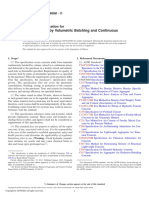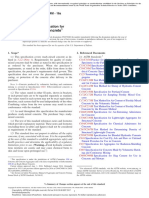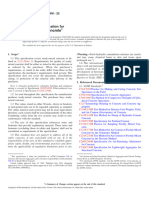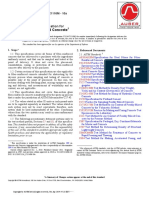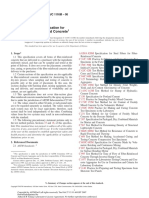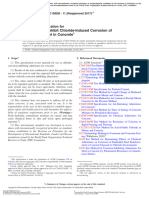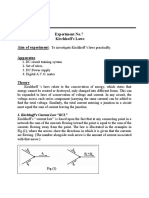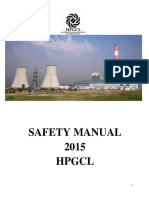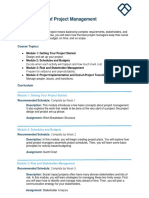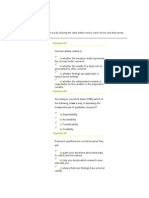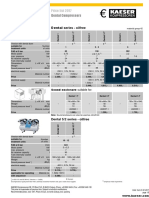Packaged, Dry, Combined Materials For Concrete and High Strength Mortar
Packaged, Dry, Combined Materials For Concrete and High Strength Mortar
Uploaded by
mickyfelixCopyright:
Available Formats
Packaged, Dry, Combined Materials For Concrete and High Strength Mortar
Packaged, Dry, Combined Materials For Concrete and High Strength Mortar
Uploaded by
mickyfelixOriginal Title
Copyright
Available Formats
Share this document
Did you find this document useful?
Is this content inappropriate?
Copyright:
Available Formats
Packaged, Dry, Combined Materials For Concrete and High Strength Mortar
Packaged, Dry, Combined Materials For Concrete and High Strength Mortar
Uploaded by
mickyfelixCopyright:
Available Formats
Designation: C387/C387M − 11b
Standard Specification for
Packaged, Dry, Combined Materials for Concrete and High
Strength Mortar1
This standard is issued under the fixed designation C387/C387M; the number immediately following the designation indicates the year
of original adoption or, in the case of revision, the year of last revision. A number in parentheses indicates the year of last reapproval.
A superscript epsilon (´) indicates an editorial change since the last revision or reapproval.
1. Scope* C125 Terminology Relating to Concrete and Concrete Ag-
1.1 This specification covers the production, properties, gregates
packaging, and testing of packaged, dry, combined materials C138/C138M Test Method for Density (Unit Weight), Yield,
for concrete and high strength mortar. The classifications of and Air Content (Gravimetric) of Concrete
concrete and mortar covered are defined in Section 3. C143/C143M Test Method for Slump of Hydraulic-Cement
NOTE 1—The scope of this standard does not cover mortars for unit Concrete
masonry. Dry preblended mortars for unit masonry are covered by C144 Specification for Aggregate for Masonry Mortar
Specification C1714/C1714M. C150 Specification for Portland Cement
1.2 The values stated in either SI units or inch-pound units C173/C173M Test Method for Air Content of Freshly Mixed
are to be regarded separately as standard. The values stated in Concrete by the Volumetric Method
each system may not be exact equivalents; therefore, each C185 Test Method for Air Content of Hydraulic Cement
system shall be used independently of the other. Combining Mortar
values from the two systems may result in non-conformance C192/C192M Practice for Making and Curing Concrete Test
with the standard. Some values have only SI units because the Specimens in the Laboratory
inch-pound equivalents are not used in practice. C207 Specification for Hydrated Lime for Masonry Pur-
1.3 The following safety hazards caveat pertains only to the poses
test method portion of this specification. This standard does not C231 Test Method for Air Content of Freshly Mixed Con-
purport to address all of the safety concerns, if any, associated crete by the Pressure Method
with its use. It is the responsibility of the user of this standard C260 Specification for Air-Entraining Admixtures for Con-
to establish appropriate safety and health practices and crete
determine the applicability of regulatory limitations prior to C270 Specification for Mortar for Unit Masonry
use. C305 Practice for Mechanical Mixing of Hydraulic Cement
Pastes and Mortars of Plastic Consistency
2. Referenced Documents C330 Specification for Lightweight Aggregates for Struc-
2.1 ASTM Standards:2 tural Concrete
C33 Specification for Concrete Aggregates C494/C494M Specification for Chemical Admixtures for
C39/C39M Test Method for Compressive Strength of Cylin- Concrete
drical Concrete Specimens C566 Test Method for Total Evaporable Moisture Content of
C91 Specification for Masonry Cement Aggregate by Drying
C109/C109M Test Method for Compressive Strength of C595 Specification for Blended Hydraulic Cements
Hydraulic Cement Mortars (Using 2-in. or [50-mm] Cube C618 Specification for Coal Fly Ash and Raw or Calcined
Specimens) Natural Pozzolan for Use in Concrete
C702 Practice for Reducing Samples of Aggregate to Testing
Size
1
This specification is under the jurisdiction of ASTM Committee C09 on C989 Specification for Slag Cement for Use in Concrete and
Concrete and Concrete Aggregatesand is the direct responsibility of Subcommittee Mortars
C09.43 on Packaged Dry Combined Materials.
Current edition approved Dec. 15, 2011. Published January 2012. Originally
C1116 Specification for Fiber-Reinforced Concrete and
approved in 1956. Last previous edition approved in 2011 as C387/C387M–11a. Shotcrete
DOI: 10.1520/C0387_C0387M-11b. C1157 Performance Specification for Hydraulic Cement
2
For referenced ASTM standards, visit the ASTM website, www.astm.org, or C1240 Specification for Silica Fume Used in Cementitious
contact ASTM Customer Service at service@astm.org. For Annual Book of ASTM
Standards volume information, refer to the standard’s Document Summary page on Mixtures
the ASTM website. C1329 Specification for Mortar Cement
*A Summary of Changes section appears at the end of this standard
Copyright © ASTM International, 100 Barr Harbor Drive, PO Box C700, West Conshohocken, PA 19428-2959. United States
Copyright by ASTM Int'l (all rights reserved); 1
C387/C387M − 11b
C1437 Test Method for Flow of Hydraulic Cement Mortar 4. Ordering Information
C1438 Specification for Latex and Powder Polymer Modi-
4.1 The purchaser shall specify the material desired as
fiers in Hydraulic Cement Concrete and Mortar
concrete or high strength mortar and the respective physical
C1600/C1600M Specification for Rapid Hardening Hydrau-
requirements as specified in Table 1 shall govern.
lic Cement
C1714/C1714M Specification for Preblended Dry Mortar
5. Materials
Mix for Unit Masonry
5.1 Materials used as ingredients in packaged, dry, com-
3. Terminology bined materials for mortar and concrete shall conform to at
3.1 Definitions— least one of the following requirements:
3.1.1 For definitions of terms used in this specification, refer 5.1.1 Aggregates, shall conform to Specification C33,
to Terminology C125. Specification C144, or Specification C330.
3.2 Definitions of Terms Specific to This Standard: 5.1.2 Air-Entraining Admixtures, shall conform to Specifi-
3.2.1 concrete, high-early strength, n—in packaged, dry, cation C260.
combined materials, a product for building and repair requiring 5.1.3 Blended Cement, shall conform to Specification C595
a more rapid than normal strength development. or Performance Specification C1157.
3.2.1.1 Discussion—This product allows for earlier removal 5.1.4 Chemical Admixtures, shall conform to Specification
of forms and allows concrete projects to be put into service C494/C494M.
much sooner than with normal strength concrete. 5.1.5 Fly ash and natural pozzolans, shall conform to
3.2.2 concrete, normal strength, n—in packaged, dry, com- Specification C618.
bined materials, a product for general building and repair 5.1.6 Ground Granulated Blast-Furnace Slag, shall con-
where thickness exceeds 50 mm [2 in.]. form to Specification C989.
3.2.2.1 Discussion—Typical uses include building or repair- 5.1.7 Hydrated Lime, shall conform to Type S or Type SA of
ing sidewalks, patios, steps, footings, and for setting posts. Specification C207.
3.2.3 concrete, normal strength, lightweight, n—in 5.1.8 Latex and Powder Polymer Modifiers, shall conform
packaged, dry, combined materials, a concrete product for to Specification C1438.
building and repair where the lightest concrete density is NOTE 2—Type II latex polymers should not be used in applications that
desirable. may be more than superficially wet in service.
3.2.3.1 Discussion—These mixtures will produce concrete
5.1.9 Masonry Cement, shall conform to Specification C91.
that is about 25 to 35 % lower in density than normal weight
concrete. 5.1.10 Mortar Cement, shall comply with C1329.
5.1.11 Portland Cement, shall conform to Type I, IA, II,
3.2.4 concrete, normal strength, lightweight using normal
IIA, III or IIIA of Specification C150.
weight sand, n—in packaged, dry, combined materials, a
5.1.12 Silica Fume, shall conform to Specification C1240.
concrete product for building and repair where a lower density
is desirable. 5.1.13 Fibers, shall conform to the applicable portions of
3.2.4.1 Discussion—These mixtures will produce concrete Specification C1116.
that is about 15 to 25 % lower in density than normal weight 5.1.14 Rapid hardening hydraulic cement, shall comply
concrete. with Specification C1600/C1600M.
3.2.5 mortar, high-strength, n—in packaged, dry, combined
6. Preparation of Aggregate
materials, a product for building or repair requiring a thickness
of less than 50 mm [2 in.], or where a high strength mortar 6.1 All aggregates prepared in the laboratory for the purpose
mixture is required. of establishing the correct proportions for the product shall be
3.2.5.1 Discussion—Typical uses include topping and dried, without disintegration, to a moisture content of less than
patching existing concrete structures. Often referred to as 0.1 % by mass. Verify moisture content using a ventilated oven
“sand mix.” in accordance with Test Method C566.
TABLE 1 Physical Requirements
Compressive Strength, MPa [psi] min
Kind of Material
3 days 7 days 28 days
Concrete:
High-early strength 17.0 [2500] 24.0 [3500] ...
Normal strength:
Normal weight ... 17.0 [2500] 24.0 [3500]
Lightweight using normal weight sandA ... 17.0 [2500] 24.0 [3500]
Lightweight ... 17.0 [2500] 24.0 [3500]
Mortar:
High-strength mortar 20.0 [3000] 35.0 [5000]
A
Lightweight concrete using normal weight sand may contain some portion of lightweight fines.
Copyright by ASTM Int'l (all rights reserved); 2
C387/C387M − 11b
7. Proportioning NOTE 3—The amount of water recommended should be the amount
required to produce a slump of 50 to 75 mm [2 to 3 in.] for concrete and
7.1 The proportions of cementitious material and aggregate a flow of 110 6 5 % for high strength mortar.
shall be such that the strength requirements will be met when
9.3 Container Construction—The strength of the container
an amount of mixing water is used that produces for concrete
shall be adequate for the mass of concrete or mortar it is
the slump specified in 14.3 and for mortar the flow specified in
intended to contain.
16.2.
10. Rejection
8. Physical Properties
10.1 The purchaser has the right to reject material that fails
8.1 Packaged, dry, combined materials for concrete and to conform to the requirements of this specification. Rejection
high strength mortar shall conform to the respective physical shall be reported to the Producer or supplier promptly and in
requirements as given in Table 1 for the material specified writing.
when the prescribed amount of water is added.
10.2 The purchaser has the right to reject product in
9. Packaging and Package Marking damaged or dampened containers.
9.1 All packages shall be identified as conforming to Speci- 11. Storage
fication C387, and as to kind and type of material listed in 11.1 Product must be stored in a dry area and shall not be
Table 1 and the net mass in each bag printed thereon. stored in direct contact with the ground or floor.
9.2 The yield in liters [cubic feet], and the amount of water
recommended for mixing shall be marked on the package.
SAMPLING AND TESTING
12. Accuracy of Measurement
12.1 Use scales conforming to the applicable sections of protected by rubber gloves, or a shovel, whichever is more
Handbook 44.3 New and reconditioned scales shall be accurate convenient. Mix the dry batch until the materials appear to be
to 60.1 % of the total capacity of the scale. When scales have uniformly distributed. Add water while mixing until the con-
been in use, they shall be accurate to 60.4 % of the total crete is homogeneous in appearance and has the desired slump.
capacity of the scale. If prolonged mixing is required because of the addition of
12.2 Record the mass of concrete in kilograms (pounds) to mixing water in increments while adjusting the slump, the
a minimum accuracy of 0.05 kg [0.1 lb.]. Record the mass of batch must be discarded and a new batch made without
mortar in grams to an accuracy of within 1 g or 0.1 %, interrupting the mixing to make trial slump tests.
whichever is greater. 14.5 Place all materials in the mixer to be used for machine
mixing. A mixing period of 3 min followed by a 3-min rest,
13. Sampling Concrete
followed by 2-min final mixing is suggested, unless a different
13.1 Use a sufficient quantity of whole packages to conduct procedure is better adapted to the mixer being used. Cover the
all testing from a single batch. open end of the mixer during the rest period to reduce
evaporation. Test the slump in accordance with Test Method
14. Mixing and Testing Concrete
C143/C143M upon completion of the mixing. If the slump test
14.1 Determine the net mass of concrete in the package (or of the mixed batch shows that additional water is required,
packages), then empty into a clean, watertight container. return the sample used for the slump test promptly to the mixer,
14.2 Mix the concrete, determine the properties of the fresh add additional water, and remix the batch for 2 min. Retest the
concrete, and mold and cure the specimens in accordance with slump. If the slump is not from 50 to 75 mm [2 to 3 in.], discard
the applicable provisions of Practice C192/C192M, or modifi- the batch.
cations of them as outlined herein. Test the strength of the 14.6 Discharge the mixed batch into a clean, watertight
concrete in accordance with Test Method C39/C39M. container that has been predampened, then remix the batch by
14.3 Mix the entire sample of the combined, dry material for hand, using a scoop or trowel, until the batch appears to be
concrete either by hand or by machine, except that hand mixing uniform. Promptly determine the density in kilograms per
is not applicable to air-entrained concrete. Add mixing water in cubic meter (or pound per cubic foot) in accordance with Test
sufficient amount to produce a slump of 50 to 75 mm [2 to 3 Method C138/C138M. Return samples used for the slump and
in.]. unit weight test to the container, then remix the batch by hand
14.4 Use a watertight, clean metal container for hand and mold the specimens.
mixing, using either a blunted bricklayer’s trowel, hands 14.7 Mold six cylinders from each batch, using three
cylinders for test at 7 days and three at 28 days, except that in
3
Specifications, Tolerances, and Other Technical Requirements of Weighing and the case of high early strength concrete, three cylinders shall be
Measuring Devices, Handbook 44, National Bureau of Standards. tested at 3 days and three at 7 days. Compression test
Copyright by ASTM Int'l (all rights reserved); 3
C387/C387M − 11b
specimens shall be cylindrical with a length equal to twice the 16.2 Mix 3000 6 3 g [6.61 6 0.01 lbs.] of mortar in accor-
diameter. The minimum specimen diameter shall be 75 mm [3 dance with Practice C305 with the exception that the combined
in.], but the maximum diameter is not limited, provided the material is added at the time of cement addition in Practice
number of specimens for a test as required in this section are C305. Additional water may be added in the final mix period to
molded from a single batch and the sample taken in accordance adjust the flow. Determine the flow in accordance with Test
with 13.1. For acceptance, the average of the strengths of the Method C1437. Use sufficient water to produce a flow of
three specimens tested at each age shall not be less than the 110 6 5 %.
compressive strength required in Table 1 for the type of 16.3 Compressive Strength—Specimens shall be 50-mm
concrete under test and no individual specimen shall have a [2-in.] cubes molded, cured, and tested in accordance with Test
strength less than 90 % of the required strength. Method C109/C109M.
14.8 The report of the tests of the concrete shall include the 16.4 Density and Yield—Determination of density of the
following: mixed mortar and yield per package of mortar.
14.8.1 Net mass of dry, combined material in the bag or 16.4.1 Vigorously remix the remaining mortar by hand for
bags determined by subtracting the mass of the empty bag or 10 s using a spoon. Consolidate the mortar into a 400-mL
bags from the gross mass of the package. measure in accordance with Test Method C185.
14.8.2 Amount of mixing water (W) calculated in terms of 16.4.2 Determine the net mass (M) of the mortar in the
kilograms (or pounds) per bag, based on mass of the bag. 400-mL measure to the nearest 1 g.
W 5 ~ W b /A ! B 16.4.3 Calculate the density of the mortar in kilograms per
cubic metre (or pounds per cubic foot) using the equations:
Wb = mass of water added to batch,
A = mass of dry material in batch, and D k 5 2.5M or ~ D p 5 0.156M ! (1)
B = printed mass of bag contents. where:
14.8.3 Slump in millimetres (or inches) in accordance with Dk = density in kilograms per cubic metre
Test Method C143/C143M. Dp = density in pounds per cubic foot
14.8.4 Density (D) in kilograms per cubic meter (or pounds 16.4.4 Calculate the yield (Y) per package in litres (cubic
per cubic foot) in accordance with Test Method C138/C138M. feet) as follows:
14.8.5 Yield (Y) of concrete as determined by Test Method
C138/C138M in terms of liters (or cubic feet) per bag, based on Y 5 ~ 11R ! PC/D (2)
printed mass of bag contents. where:
14.8.6 Air content, if required, shall be determined by one R = ratio of mass (or weight) of mixing water to mass (or
of the following Test Methods: C138/C138M, C173/C173M, weight) of dry combined material in the batch of
(suggested for lightweight concrete); or C231. The method mortar.
used to determine the air content shall be reported. P = the net mass (or weight) printed on the package.
14.8.7 Compressive strength at the ages specified in Table 1; C = Conversion factor. To determine the yield in litres, P
report the method of mixing the concrete. State the size of the must be in kilograms per cubic metre. The conversion
cylinder used in the report. factor is 1000. To determine the yield in pounds per
cubic foot; P must be in pounds and D must be in
15. Sampling Mortar pounds per cubic foot. The conversion factor is 1.
15.1 The contents of an entire package of dry, combined 16.5 Air Content (optional)—If the mixture proportions are
material for high strength mortar shall be used as a sample. known, calculate the air content in accordance with Specifica-
Determine the gross mass of the package and contents to the tion C270. If the proportions are not known, use Test Method
nearest 0.05 kg [0.1 lb.]. Empty the entire contents of the C138/C138M, or Test Method C173/C173M, or Test Method
package into a clean, watertight container. Determine the mass C231 to determine air content.
of the empty package and calculate the net mass of the package 16.6 The report of the tests shall include:
from the gross mass of the package and contents. Reduce the 16.6.1 Net mass (or weight) of dry, combined material in the
sample to the proper size for testing in accordance with bag determined to 0.05 kg [0.1 lb],
Practice C702.
16.6.2 Amount of mixing water (W) calculated in accor-
dance with the formula specified in 14.8.2,
16. Mixing and Testing Mortar 16.6.3 Flow, in accordance with Test Method C1437,
16.1 Mortar mixing equipment shall be as specified in 16.6.4 Density (D) in kilograms per cubic metre [pounds per
Practice C305, except that the mixer must be provided with a cubic foot] as determined in 16.4 in accordance with Test
bowl positioning adapter (See Note 4) to ensure clearance for Method C138/C138M,
the largest size aggregate in the mix being tested. The mixing 16.6.5 Yield (Y) of mortar in liters [cubic feet] as deter-
procedure shall be modified as given in 16.2. mined in 16.4,
NOTE 4—Description of such an adapter may be obtained from the
16.6.6 Air content, if measured, and test method used to
Cement and Concrete Reference Laboratory of the National Institute of determine air content, and
Standards Technology. 16.6.7 Compressive strength at ages specified in Table 1.
Copyright by ASTM Int'l (all rights reserved); 4
C387/C387M − 11b
17. Keywords bined concrete/mortar materials; mortar-cement mortar;
17.1 aggregate-cement aggregate combinations; cement mortar, packaged; packaged dry combined materials; packaged
mortars; combined concrete/mortar materials; concrete admix- concrete/mortar materials
tures; concrete, packaged; concrete specifications; dry com-
SUMMARY OF CHANGES
Committee C09 has identified the location of selected changes to this specification since the last issue,
C387/C387M–11a, that may impact the use of this specification. (Approved December 15, 2011)
(1) Revised the title and 1.1.
Committee C09 has identified the location of selected changes to this specification since the last issue,
C387/C387M–11, that may impact the use of this specification. (Approved October 15, 2011)
(1) Added Specifications C91, C207, C1116, C1329, and (2) Revised 5.1.5.
C1600/C1600M to Section 5 and Referenced Documents. (3) Deleted Test Method C109/C109M from 16.3.
Committee C09 has identified the location of selected changes to this specification since the last issue,
C387/C387M–10, that may impact the use of this specification. (Approved January 1, 2011)
(1) Removed mortars for unit masonry; these materials are now
covered by Specification .
ASTM International takes no position respecting the validity of any patent rights asserted in connection with any item mentioned
in this standard. Users of this standard are expressly advised that determination of the validity of any such patent rights, and the risk
of infringement of such rights, are entirely their own responsibility.
This standard is subject to revision at any time by the responsible technical committee and must be reviewed every five years and
if not revised, either reapproved or withdrawn. Your comments are invited either for revision of this standard or for additional standards
and should be addressed to ASTM International Headquarters. Your comments will receive careful consideration at a meeting of the
responsible technical committee, which you may attend. If you feel that your comments have not received a fair hearing you should
make your views known to the ASTM Committee on Standards, at the address shown below.
This standard is copyrighted by ASTM International, 100 Barr Harbor Drive, PO Box C700, West Conshohocken, PA 19428-2959,
United States. Individual reprints (single or multiple copies) of this standard may be obtained by contacting ASTM at the above
address or at 610-832-9585 (phone), 610-832-9555 (fax), or service@astm.org (e-mail); or through the ASTM website
(www.astm.org). Permission rights to photocopy the standard may also be secured from the ASTM website (www.astm.org/
COPYRIGHT/).
Copyright by ASTM Int'l (all rights reserved); 5
You might also like
- Astm C94Document15 pagesAstm C94Enrique Pasquel100% (4)
- Astm C94Document16 pagesAstm C94carlos salinas100% (1)
- Concrete Made by Volumetric Batching and Continuous Mixing: Standard Specification ForDocument9 pagesConcrete Made by Volumetric Batching and Continuous Mixing: Standard Specification Formickyfelix100% (2)
- Abrasion Resistance of Horizontal Concrete Surfaces: Standard Test Method ForDocument7 pagesAbrasion Resistance of Horizontal Concrete Surfaces: Standard Test Method FormickyfelixNo ratings yet
- Using The Seismic-Reflection Method For Shallow Subsurface InvestigationDocument26 pagesUsing The Seismic-Reflection Method For Shallow Subsurface InvestigationmickyfelixNo ratings yet
- Estimating The Permanganate Natural Oxidant Demand of Soil and Aquifer SolidsDocument5 pagesEstimating The Permanganate Natural Oxidant Demand of Soil and Aquifer SolidsmickyfelixNo ratings yet
- Ready-Mixed Concrete: Standard Specification ForDocument15 pagesReady-Mixed Concrete: Standard Specification ForHishmat Ezz AlarabNo ratings yet
- Slag Cement For Use in Concrete and MortarsDocument8 pagesSlag Cement For Use in Concrete and MortarsninaNo ratings yet
- Astm c33Document11 pagesAstm c33Kiko Nobre100% (1)
- Astm C 33Document11 pagesAstm C 33rokealpha100% (2)
- Astm C270.25146Document14 pagesAstm C270.25146Isabel100% (1)
- PNP Next Genin VDocument22 pagesPNP Next Genin VAiseba Lezba Remle100% (3)
- Accomplishment Report IctDocument2 pagesAccomplishment Report IctMark Andrew87% (61)
- Astm c387 الملاط الجاف المعبأDocument5 pagesAstm c387 الملاط الجاف المعبأMahmoud AjlouniNo ratings yet
- Astm C685C685MDocument9 pagesAstm C685C685Mzhungjian586No ratings yet
- Ready-Mixed Concrete: Standard Specification ForDocument13 pagesReady-Mixed Concrete: Standard Specification ForJesús Luis Arce GuillermoNo ratings yet
- C685C685M 14Document9 pagesC685C685M 14Alvin BaraNo ratings yet
- C94-16a READY MIXED CONCRETE PDFDocument14 pagesC94-16a READY MIXED CONCRETE PDFKartika Setia RiniNo ratings yet
- Ready-Mixed Concrete: Standard Specification ForDocument14 pagesReady-Mixed Concrete: Standard Specification Forrohitshukla23No ratings yet
- Astm C94 - C94M - 22Document15 pagesAstm C94 - C94M - 22rupeshkumar.tpl100% (1)
- Astm C94-20Document3 pagesAstm C94-20Mah MoodNo ratings yet
- Ready-Mixed Concrete: Standard Specification ForDocument15 pagesReady-Mixed Concrete: Standard Specification ForLogan PatrickNo ratings yet
- Ready-Mixed Concrete: Standard Specification ForDocument15 pagesReady-Mixed Concrete: Standard Specification ForqaqcmepteamNo ratings yet
- Astm C94 - 2021-3Document15 pagesAstm C94 - 2021-3mohamed nomanNo ratings yet
- ASTM-C1293-C1293M-23aDocument3 pagesASTM-C1293-C1293M-23apankaj rawatNo ratings yet
- C1116-C1116M - 10aDocument7 pagesC1116-C1116M - 10aElder SantosNo ratings yet
- Ready-Mixed Concrete: Standard Specification ForDocument12 pagesReady-Mixed Concrete: Standard Specification ForjasimabdNo ratings yet
- Ready-Mixed Concrete: Standard Specification ForDocument15 pagesReady-Mixed Concrete: Standard Specification ForYnmer GallegosNo ratings yet
- ASTM C94 Mixed ConcreteDocument13 pagesASTM C94 Mixed ConcreteZega ChrisNo ratings yet
- ASTM C94-21 Standard Specification For Ready Mix ConcreteDocument7 pagesASTM C94-21 Standard Specification For Ready Mix Concreteryann mananquilNo ratings yet
- Ready-Mixed Concrete: Standard Specification ForDocument15 pagesReady-Mixed Concrete: Standard Specification ForSupervisión Durango MazatlanNo ratings yet
- ASTM C1116 Fiber Reinforced ConcreteDocument7 pagesASTM C1116 Fiber Reinforced Concretechenyahang9No ratings yet
- Astm C116-15 PDFDocument7 pagesAstm C116-15 PDFDanny LiangNo ratings yet
- Fiber-Reinforced Concrete: Standard Specification ForDocument7 pagesFiber-Reinforced Concrete: Standard Specification FormickyfelixNo ratings yet
- Determination of Length Change of Concrete Due To Alkali-Silica ReactionDocument7 pagesDetermination of Length Change of Concrete Due To Alkali-Silica Reactioniipmnpti iipm100% (1)
- Processing Additions For Use in The Manufacture of Hydraulic CementsDocument5 pagesProcessing Additions For Use in The Manufacture of Hydraulic CementsDIEGO MARCELO JUELA QUINTUÑANo ratings yet
- ASTM C1116M-10a Standard Specification For Fiber-Reinforced ConcreteDocument7 pagesASTM C1116M-10a Standard Specification For Fiber-Reinforced ConcretePatrick DimaculanganNo ratings yet
- Mortar Cement: Standard Specification ForDocument4 pagesMortar Cement: Standard Specification ForMaiNo ratings yet
- ASTM C989 C989M 18aDocument3 pagesASTM C989 C989M 18amohaliaziz8No ratings yet
- ASTM C1116-10aDocument8 pagesASTM C1116-10aViết DuyNo ratings yet
- Concrete Made by Volumetric Batching and Continuous Mixing: Standard Specification ForDocument9 pagesConcrete Made by Volumetric Batching and Continuous Mixing: Standard Specification ForCory BradleyNo ratings yet
- Ready-Mixed Concrete: Standard Specification ForDocument12 pagesReady-Mixed Concrete: Standard Specification ForAnas KhallafNo ratings yet
- Astm C226 2012 PDFDocument5 pagesAstm C226 2012 PDFjuanMNo ratings yet
- ASTM C33 11 Conc AggregatesDocument11 pagesASTM C33 11 Conc AggregatesLuis VelardeNo ratings yet
- Astm C928C928M-13Document5 pagesAstm C928C928M-13adolfo camayoNo ratings yet
- C233 - C233M-11 Standard Test Method For Air-Entraining Admixtures For ConcreteDocument5 pagesC233 - C233M-11 Standard Test Method For Air-Entraining Admixtures For ConcreteAfra AliNo ratings yet
- Astm C595-C595M-16Document8 pagesAstm C595-C595M-16Jesus Luis Arce GuillermoNo ratings yet
- ASTM Slag CementDocument8 pagesASTM Slag CementkhaledNo ratings yet
- ASTM C1116 - Standard Specification For Fiber Reinforced Concrete PDFDocument7 pagesASTM C1116 - Standard Specification For Fiber Reinforced Concrete PDFibrahimNo ratings yet
- Astm C94 C94M 06Document6 pagesAstm C94 C94M 06Mohaa rabiaNo ratings yet
- ASTM C192 C192M-15 Standard Practice For Making and Curing Concrete Test SpecimeDocument8 pagesASTM C192 C192M-15 Standard Practice For Making and Curing Concrete Test Specime贺朝勇No ratings yet
- ASTM C 192Document8 pagesASTM C 192Sardar KhudhurNo ratings yet
- Ready-Mixed Concrete: Standard Specification ForDocument16 pagesReady-Mixed Concrete: Standard Specification Formuqeem khanNo ratings yet
- C387C387M - 06aDocument5 pagesC387C387M - 06aJesús Luis Arce GuillermoNo ratings yet
- C94C94M-Concreto PremezcladoDocument11 pagesC94C94M-Concreto PremezcladoAnthony López HuamanNo ratings yet
- C1157C1157MDocument5 pagesC1157C1157Ming.castanon.42101243No ratings yet
- ASTM C1582-17 Standard Specification For Admixtures To Inhibit Chloride-Induced Corrosion of Reinforcing Steel in ConcreteDocument10 pagesASTM C1582-17 Standard Specification For Admixtures To Inhibit Chloride-Induced Corrosion of Reinforcing Steel in Concretebenedick barquinNo ratings yet
- Astm c192Document8 pagesAstm c192anon_533103905No ratings yet
- Blended Hydraulic Cements: Standard Specification ForDocument8 pagesBlended Hydraulic Cements: Standard Specification ForElena CabreraNo ratings yet
- Astm C33 C33M-13Document11 pagesAstm C33 C33M-13MilonNo ratings yet
- Astm C 94 - 21 (A)Document15 pagesAstm C 94 - 21 (A)Diego AntonioNo ratings yet
- Astm C595-15Document13 pagesAstm C595-15ptn Vicem Bút SơnNo ratings yet
- Durability Design of Concrete Structures: Phenomena, Modeling, and PracticeFrom EverandDurability Design of Concrete Structures: Phenomena, Modeling, and PracticeNo ratings yet
- Civil Engineering Structures According to the Eurocodes: Inspection and MaintenanceFrom EverandCivil Engineering Structures According to the Eurocodes: Inspection and MaintenanceNo ratings yet
- Advanced and Refractory Ceramics for Energy Conservation and EfficiencyFrom EverandAdvanced and Refractory Ceramics for Energy Conservation and EfficiencyHua-Tay LinNo ratings yet
- Developing Appropriate Statistical Approaches For Groundwater Detection Monitoring ProgramsDocument15 pagesDeveloping Appropriate Statistical Approaches For Groundwater Detection Monitoring ProgramsmickyfelixNo ratings yet
- Total Evaporable Moisture Content of Aggregate by Drying: Standard Test Method ForDocument3 pagesTotal Evaporable Moisture Content of Aggregate by Drying: Standard Test Method FormickyfelixNo ratings yet
- Chemical Admixtures For Use in Producing Flowing ConcreteDocument9 pagesChemical Admixtures For Use in Producing Flowing Concretemickyfelix100% (1)
- Fiber-Reinforced Concrete: Standard Specification ForDocument7 pagesFiber-Reinforced Concrete: Standard Specification FormickyfelixNo ratings yet
- Coal Fly Ash and Raw or Calcined Natural Pozzolan For Use in ConcreteDocument5 pagesCoal Fly Ash and Raw or Calcined Natural Pozzolan For Use in ConcretemickyfelixNo ratings yet
- Latex Agents For Bonding Fresh To Hardened ConcreteDocument2 pagesLatex Agents For Bonding Fresh To Hardened ConcretemickyfelixNo ratings yet
- In-Place Density of Unhardened and Hardened Concrete, Including Roller Compacted Concrete, by Nuclear MethodsDocument5 pagesIn-Place Density of Unhardened and Hardened Concrete, Including Roller Compacted Concrete, by Nuclear MethodsmickyfelixNo ratings yet
- Determining Density of Structural Lightweight Concrete: Standard Test Method ForDocument4 pagesDetermining Density of Structural Lightweight Concrete: Standard Test Method FormickyfelixNo ratings yet
- Splitting Tensile Strength of Cylindrical Concrete SpecimensDocument5 pagesSplitting Tensile Strength of Cylindrical Concrete SpecimensmickyfelixNo ratings yet
- Determination of Temporary Ditch Check Performance in Protecting Earthen Channels From Stormwater-Induced ErosionDocument8 pagesDetermination of Temporary Ditch Check Performance in Protecting Earthen Channels From Stormwater-Induced ErosionmickyfelixNo ratings yet
- Lightweight Aggregates For Structural ConcreteDocument4 pagesLightweight Aggregates For Structural ConcretemickyfelixNo ratings yet
- Lightweight Aggregates For Insulating ConcreteDocument3 pagesLightweight Aggregates For Insulating ConcretemickyfelixNo ratings yet
- Sampling and Testing Fly Ash or Natural Pozzolans For Use in Portland-Cement ConcreteDocument10 pagesSampling and Testing Fly Ash or Natural Pozzolans For Use in Portland-Cement ConcretemickyfelixNo ratings yet
- Lightweight Aggregates For Concrete Masonry UnitsDocument4 pagesLightweight Aggregates For Concrete Masonry UnitsmickyfelixNo ratings yet
- Consolidated Drained Triaxial Compression Test For SoilsDocument11 pagesConsolidated Drained Triaxial Compression Test For SoilsmickyfelixNo ratings yet
- Highway Traffic Monitoring Truth-in-Data: Standard Practice ForDocument5 pagesHighway Traffic Monitoring Truth-in-Data: Standard Practice FormickyfelixNo ratings yet
- Field Pneumatic Slug (Instantaneous Change in Head) Tests To Determine Hydraulic Properties of Aquifers With Direct Push Groundwater SamplersDocument15 pagesField Pneumatic Slug (Instantaneous Change in Head) Tests To Determine Hydraulic Properties of Aquifers With Direct Push Groundwater SamplersmickyfelixNo ratings yet
- Measuring Deflections Using A Portable Impulse Plate Load Test DeviceDocument5 pagesMeasuring Deflections Using A Portable Impulse Plate Load Test Devicemickyfelix100% (1)
- Preformed Polychloroprene Elastomeric Joint Seals For BridgesDocument4 pagesPreformed Polychloroprene Elastomeric Joint Seals For BridgesmickyfelixNo ratings yet
- Astm C 215Document7 pagesAstm C 215mickyfelixNo ratings yet
- Air-Entraining Admixtures For ConcreteDocument4 pagesAir-Entraining Admixtures For ConcretemickyfelixNo ratings yet
- SRS Canteen Management System: (Software Requirements Specification) Web ApplicationDocument7 pagesSRS Canteen Management System: (Software Requirements Specification) Web ApplicationabbasNo ratings yet
- PCP (Progressive Cavity Pump)Document7 pagesPCP (Progressive Cavity Pump)SHOBHIT KUMAR100% (2)
- Experiment No.7 Kirchhoff's Laws Aim of Experiment ApparatusDocument5 pagesExperiment No.7 Kirchhoff's Laws Aim of Experiment ApparatusMohsin Iqbal Department of Electrical EngineeringNo ratings yet
- Jharkhand 04092012Document51 pagesJharkhand 04092012Ram NamburiNo ratings yet
- Arduino Based Automatic Pneumatic SystemDocument31 pagesArduino Based Automatic Pneumatic Systemnklharish1No ratings yet
- Lunalys Outdoor Luminaires Data Sheet EN tcm181-12688Document5 pagesLunalys Outdoor Luminaires Data Sheet EN tcm181-12688Patrick MorcosNo ratings yet
- Safety Manual 2015 HPGCLDocument164 pagesSafety Manual 2015 HPGCLஉம்முமுத,100% (1)
- Polyethylene InsulationDocument2 pagesPolyethylene InsulationJeghi100% (1)
- Bimetal Thermometer Accuracy Definitions: Asme B40.3 Standard Accuracies: AccuracyDocument1 pageBimetal Thermometer Accuracy Definitions: Asme B40.3 Standard Accuracies: AccuracyabcNo ratings yet
- Yoruba TownDocument2 pagesYoruba Townapi-327516856100% (2)
- Syllabus Fundamentals of Project Management StaticDocument2 pagesSyllabus Fundamentals of Project Management StaticAbdelnasir HaiderNo ratings yet
- Livable Streets: Through A Walkable InterventionDocument15 pagesLivable Streets: Through A Walkable InterventionDivyah RatheeshNo ratings yet
- APDOCDocument392 pagesAPDOCkhan_sadiNo ratings yet
- Chapter 02Document7 pagesChapter 02Abhishek Kalra50% (2)
- STUDY TIME LEARNING - Computer Science Operating System MCQs For NTS TestDocument4 pagesSTUDY TIME LEARNING - Computer Science Operating System MCQs For NTS TestAsadNo ratings yet
- Valid DocumentDocument1 pageValid Documentmeeseva727No ratings yet
- Artikel Specifying Magnetic Bearings PDFDocument2 pagesArtikel Specifying Magnetic Bearings PDFAgustin A.100% (1)
- Catalogo Errecom Es-1Document84 pagesCatalogo Errecom Es-1diego suazoNo ratings yet
- GI Project Management GI Project Management: Logical Framework Matrix Logical Framework MatrixDocument2 pagesGI Project Management GI Project Management: Logical Framework Matrix Logical Framework MatrixLeo DobreciNo ratings yet
- Study On The Utilization of Coconut Shell As Coarse Aggregate in ConcreteDocument50 pagesStudy On The Utilization of Coconut Shell As Coarse Aggregate in ConcreteDr Sachin Chitnis M O UPHC AiroliNo ratings yet
- EchoDocument38 pagesEchomealysrNo ratings yet
- Drop Ship Return FlowDocument2 pagesDrop Ship Return FlowSmart DiamondNo ratings yet
- ISO 38500 - IT Security Governance FrameworkDocument15 pagesISO 38500 - IT Security Governance FrameworkJonathan Segal100% (2)
- Dental-E 2017Document5 pagesDental-E 2017Perc AleksandarNo ratings yet
- IEC StandardDocument23 pagesIEC StandardSyedAhsanAbbasBokhari0% (1)
- Sem-Safe Water Mist: NotesDocument1 pageSem-Safe Water Mist: NotesRaluca OlaruNo ratings yet
- Ferroli RGA EuroventDocument1 pageFerroli RGA EuroventKenan TaletovicNo ratings yet
- ClinitekStatusPlus 2019Document2 pagesClinitekStatusPlus 2019An NguyenNo ratings yet


